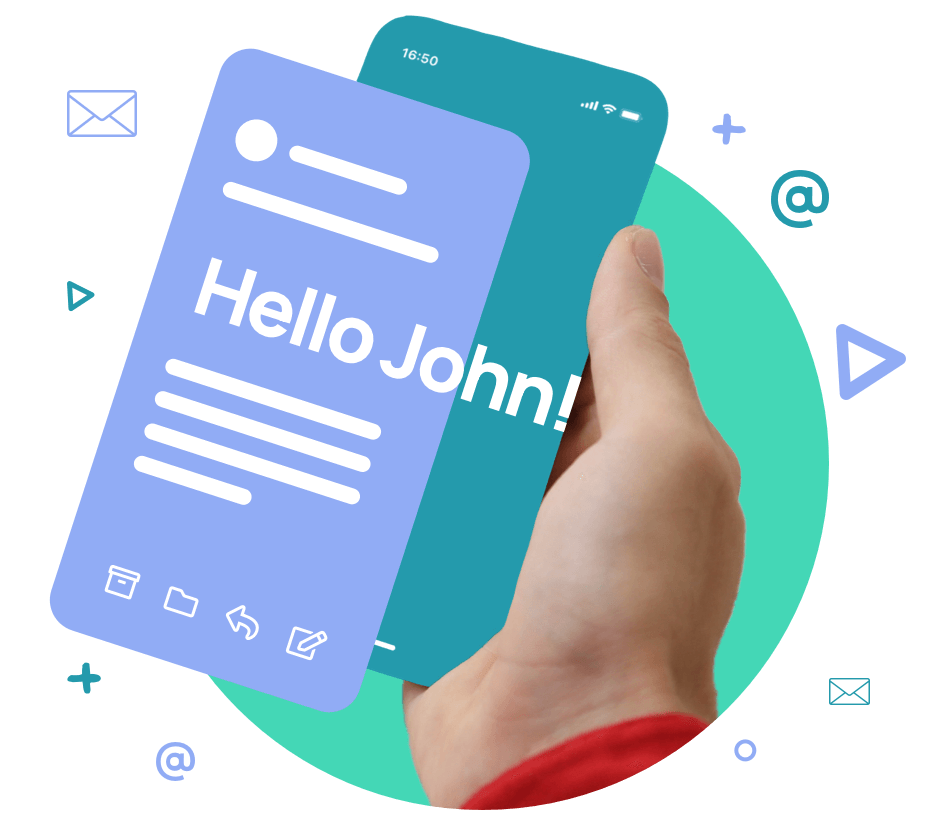Quick Links
In today’s digital landscape, the integration of AI Chatbot in marketing strategies has become increasingly prevalent. Businesses are leveraging this innovative technology to engage their customers. According to a recent study, the chatbot market size is expected to surge from $7.01 billion to a staggering $20.81 billion by 2029. This remarkable growth highlights the immense potential of AI chatbots to revolutionize customer interactions and reshape the marketing landscape. With the chatbot market poised for exponential growth, it’s clear that this technology is here to stay and businesses that don’t embrace it risk falling behind.
What is Chatbot Marketing?
Chatbot marketing is a technique that leverages automated messaging to communicate directly with customers throughout the purchasing journey. This may look like assisting them with making a purchase, enrolling for a free trial, downloading an asset and more.
Chatbot marketing uses artificial intelligence (AI) and natural language processing (NLP) to understand and respond to customer queries in a human-like way. Chatbots can also learn from customer feedback and behavior to improve their performance and deliver personalized experiences.
Chatbot marketing can help you achieve all the important marketing goals, such as:
- Increasing website traffic and engagement
- Generating and qualifying leads
- Collecting customer data and feedback
- Building chatbot for customer support and education
- Building customer loyalty and retention
- Driving conversions and sales
Benefits of Chatbot Marketing
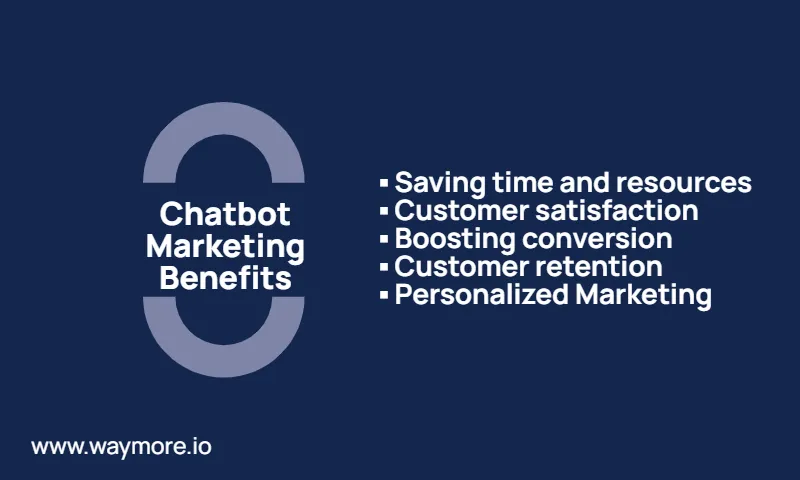
Chatbot marketing can offer many benefits for your business, such as:
Saving time and resources
Chatbots can handle multiple conversations at once, 24/7, without the need for human intervention. This can reduce your operational costs and free up your staff to focus on more complex tasks.
Improving customer satisfaction
Chatbots can provide instant and accurate answers to customer questions, reducing wait times and frustration. Chatbots can also offer personalized recommendations and offers based on customer preferences and behavior, increasing customer satisfaction and trust.
Boosting conversion optimization rates
Chatbots can guide customers through the sales funnel, providing relevant information, overcoming objections, and creating a sense of urgency. Chatbots can also upsell and cross-sell products and services, increasing the average order value and revenue.
Enhancing customer retention
Chatbots can follow up with customers after a purchase, providing support, feedback, and loyalty rewards. Chatbots can also re-engage customers who have abandoned their carts or browsed your website, reminding them of the value proposition and encouraging them to complete their purchase.
Personalization
Chatbots can gather data about user preferences and buying habits. This data can be used to deliver personalized marketing messages and product recommendations, leading to higher conversion rates.
How to Use Chatbots for Marketing
There are many ways to use chatbots for marketing, depending on your business goals and target audience.
Here are some examples of how chatbots can help you with different stages of the customer journey:
Awareness
Chatbots can help you attract new visitors to your website by promoting your content, offers, and events on social media, email, and other channels. Chatbots can also greet visitors on your website and offer them a quick overview of your products or services, creating a positive first impression.
Interest
Your visitors can gain interest in your site through chatbots by receiving valuable information, such as blog posts, case studies, testimonials, and FAQs. Chatbots can also segment your visitors based on their needs, interests, and behavior, and direct them to the most relevant pages or resources on your website.
Consideration
Chatbots can help you nurture your leads by providing them with personalized solutions, benefits, and incentives. Chatbots can also collect lead information, such as name, email, phone number, and company, and store it in your CRM or email marketing tool for further follow-up.
Decision
Chatbots can help you convert your leads into customers by addressing their pain points, objections, and concerns. Chatbots can also create a sense of urgency and scarcity, by showing limited-time offers, discounts, and social proof. Additionally, chatbots can simplify the checkout process by integrating with payment gateways, shipping providers, and order confirmation systems..
Loyalty
Chatbots can help you retain your customers by providing them with post-purchase support, feedback, and rewards. Chatbots can also upsell and cross-sell related products and services, by analyzing customer purchase history and behavior. By sending personalized messages, reminders, and offers, chatbots can also re-engage inactive customers.
How to use Chatbots for Lead Generation
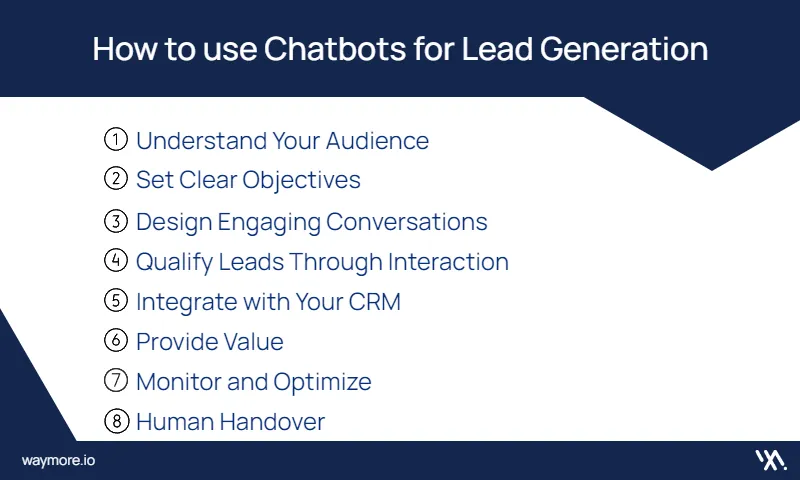
Using chatbots for lead generation is an innovative approach that combines the efficiency of automation with the personal touch of human interaction.
Here’s how you can leverage chatbots to enhance your lead generation efforts:
1. Understand Your Audience
Before deploying a chatbot, it’s crucial to understand your target audience. Create detailed buyer personas to tailor the chatbot’s interactions to meet the specific needs and preferences of different customer segments.
2. Set Clear Objectives
Define what you want to achieve with your chatbot. Whether it’s collecting email addresses, scheduling appointments, or providing product recommendations, having clear objectives will guide the chatbot’s design and functionality.
3. Design Engaging Conversations
Craft conversations that are not only informative but also engaging. Use a friendly tone and interactive elements like quick replies to keep potential leads interested and engaged.
4. Qualify Leads Through Interaction
Use your chatbot to ask qualifying questions that help you understand the lead’s position in the sales funnel. This information can be used to personalize future interactions and direct leads to the appropriate sales team.
5. Integrate with Your CRM
Connect your chatbot with your customer relationship management (CRM) system to seamlessly transfer lead information. This ensures that no data is lost and that leads can be nurtured effectively.
6. Provide Value
Ensure that your chatbot provides value to the user. Whether it’s answering questions, providing helpful content, or offering discounts, the chatbot should enhance the user’s experience and encourage them to move further down the sales funnel.
7. Monitor and Optimize
Regularly analyze the chatbot’s performance and optimize its conversations based on user feedback and behavior. This continuous improvement will help you generate more qualified leads over time.
8. Human Handover
While chatbots are powerful, they can’t handle everything. Have a system in place for the chatbot to hand over complex queries to a human representative, ensuring that leads receive the help they need.
How to use Chatbots to Collect Customer Information for Marketing Campaigns
In today’s digital world, attention spans are short and inboxes are overflowing. So, how do you gather valuable customer information for marketing campaigns without seeming intrusive? Chatbots offer a solution by engaging customers in a conversational way.
These AI-powered chat programs can collect a wealth of data, from basic contact details to preferences and buying habits. But how do you ensure this information is gathered ethically and used effectively?
The key is transparency. Be upfront about what data you’re collecting and how you’ll use it. In exchange for their information, offer customers a valuable experience. This could be a discount code, early access to new products, or personalized content.
Here’s how chatbots can collect customer information:
Interactive quizzes and polls
Chatbots can guide customers through fun quizzes that reveal their interests, all while collecting valuable data.
Personalized product recommendations
Based on a customer’s conversation, the chatbot can suggest relevant products or services.
Lead generation
Chatbots can qualify leads by asking targeted questions, saving your sales team valuable time.
Chatbot Marketing Strategies for Ecommerce
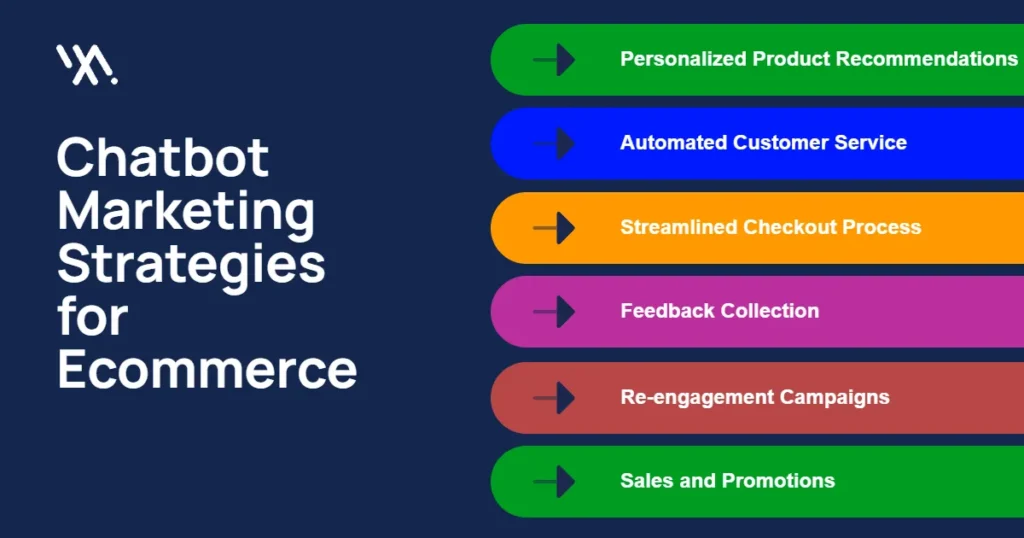
In the dynamic world of e-commerce, chatbot marketing strategies are revolutionizing the way online stores interact with customers.
Here are 6 key strategies to effectively use chatbots for e-commerce:
Personalized Product Recommendations
Chatbots can analyze customer data to suggest products tailored to their preferences, boosting the likelihood of a purchase.
Automated Customer Service
Chatbots provide instant responses to common inquiries, improving customer satisfaction and freeing up human agents for complex issues.
Streamlined Checkout Process
By guiding customers through the payment process, chatbots can reduce cart abandonment and enhance the user experience.
Feedback Collection
Post-purchase, chatbots can gather customer feedback, providing valuable insights for business improvement.
Re-engagement Campaigns
Chatbots can send targeted messages to customers who have shown interest in products, encouraging them to revisit the store.
Sales and Promotions
Chatbots can inform customers about ongoing sales and exclusive offers, driving conversions and increasing average order value.
Chatbot Marketing Examples for Small Businesses
To inspire you, here are some chatbot marketing examples for small businesses that have successfully used chatbots to engage, nurture, and convert their customers.
Slush
Slush is a global startup and tech event that uses a chatbot to automate customer service and provide information to attendees. The chatbot answers over 12,000 questions, with a 90% accuracy rate, and has reduced the workload of the customer service team by 66%.
Bestseller
Bestseller is a fashion retailer that uses a chatbot to help customers find the best products for their style and budget. The chatbot asks customers a series of questions, such as their gender, occasion, and preferred color, and then recommends products based on their answers. The chatbot has increased conversions by 52% and average order value by 13%.
The Dufresne Group
The Dufresne Group is a furniture retailer that uses a chatbot to increase online sales and customer satisfaction. The chatbot helps customers browse and buy products, by showing them images, videos, and reviews. The chatbot also offers discounts, free delivery, and financing options, to encourage customers to complete their purchase. The chatbot has increased online sales by 15% and customer satisfaction by 25%.
Best Practices for Implementing Chatbot Marketing Strategies
To make the most of chatbot marketing, here are some best practices to follow:
Define your chatbot’s goals and audience
Before you create your chatbot, you need to have a clear idea of what you want it to achieve and who you want it to serve. This will help you design your chatbot’s conversation flow, tone, and personality, and ensure that it meets the needs and expectations of your customers.
Choose the right chatbot platform
In today’s tech world, there are loads of different chatbot platforms to choose from, each with its own cool features. But right now, the ones that everyone’s talking about are the automation and omnichannel AI chatbot platforms. These platforms are super smart because they can do things automatically and work on lots of different apps and websites at once.
Whether you’re running a small business or a big company, picking the right chatbot platform is really important. And these AI chatbot platforms are winning people over because they offer solutions that fit all kinds of different business needs.
Test and optimize your chatbot
Before you launch your chatbot, you need to test it thoroughly and make sure that it works as intended. You also need to monitor your chatbot’s analytics and feedback, and make improvements based on the data and insights you gather.
Provide a human fallback option
No matter how smart your chatbot is, there will be times when it won’t be able to handle a customer’s request or question. In such cases, you need to provide a human fallback option, such as a live chat, phone, or email support. This will ensure that your customers don’t get frustrated or leave your website without getting a resolution.
Align your chatbot with your brand voice and tone
Your chatbot should reflect your brand personality and values, and communicate with your customers in a consistent and appropriate way. You can use humor, emojis, gifs, or images to make your chatbot more engaging and human-like, but don’t overdo it or pretend that your chatbot is a real person. You should also use clear and simple language, avoid jargon and slang, and use proper grammar and punctuation.
Provide an easy way to opt-out or switch to a human agent
Your chatbot should respect your customers’ preferences and choices, and not force them to interact with it if they don’t want to. You should provide an easy way for your customers to opt-out of the chatbot conversation, such as a button, a menu, or a keyword. You should also provide an option to switch to a human agent if the chatbot cannot handle the customer’s request or question, or if the customer prefers to talk to a real person.
Focus on User Experience (UX)
The chatbot experience should be user-friendly and intuitive. Make sure users can easily find the information they need and complete tasks without frustration.
Integrate with Marketing Automation
Integrate your chatbot with your marketing automation platform to capture leads, nurture them through the sales funnel, and trigger targeted marketing campaigns.
How do I measure Chatbot Marketing ROI
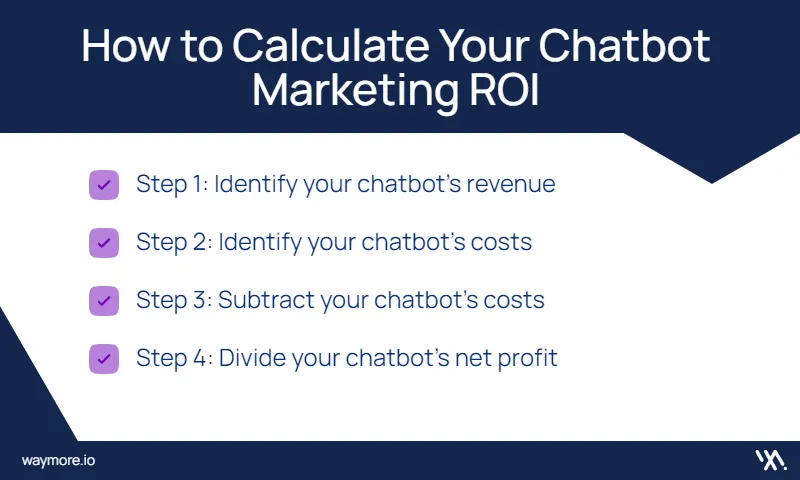
Chatbot marketing ROI is a metric that shows how much value your chatbot brings to your marketing strategy. It compares the revenue generated by your chatbot to the cost of developing and maintaining it. A positive chatbot marketing ROI means that your chatbot is profitable and effective, while a negative one means that your chatbot is losing money and needs improvement.
To calculate your chatbot marketing ROI, you need to follow these steps:
Step 1: Identify your chatbot’s revenue sources
These are the ways your chatbot contributes to your income, such as generating leads, increasing conversions, upselling products, or reducing customer service costs. You need to estimate how much money your chatbot makes from each source, either by using analytics tools or by making assumptions based on industry benchmarks or historical data.
Step 2: Identify your chatbot’s costs
These are the expenses involved in creating and running your chatbot, such as development, maintenance, hosting, integration, or marketing. You need to calculate how much money you spend on each cost, either by using invoices, receipts, or time tracking tools.
Step 3: Subtract your chatbot’s costs from your chatbot’s revenue
This will give you your chatbot’s net profit, which is the amount of money your chatbot earns after deducting its expenses.
Step 4: Divide your chatbot’s net profit by your chatbot’s costs
This will give you your chatbot’s ROI percentage, which is the ratio of your chatbot’s profit to your chatbot’s investment. A higher percentage means a higher return, while a lower percentage means a lower return.
Multiply your chatbot’s ROI percentage by 100. This will give you your chatbot’s ROI in a more readable format.
Example
Let’s say your chatbot generates $10,000 in revenue per month from lead generation and conversion, and costs $2,000 per month to develop and maintain.
Your Lead generation chatbot’s net profit is $10,000 – $2,000 = $8,000.
Your chatbot’s ROI percentage is $8,000 / $2,000 = 4.
Your chatbot’s ROI is 4 x 100 = 400%.
This means that for every dollar you invest in your chatbot, you get four dollars back. This is a very high and positive chatbot marketing ROI, indicating that your chatbot is a valuable asset for your business.
However, chatbot marketing ROI is not a static or fixed number. It can change over time, depending on various factors, such as customer behavior, chatbot performance, market trends, or business goals. Therefore, you need to measure and monitor your chatbot marketing ROI regularly, and make adjustments and improvements as needed.
Conclusion
In conclusion, the transformative power of chatbot marketing cannot be overstated. By leveraging this innovative tool, businesses can revolutionize customer engagement, streamline lead generation processes, and ultimately drive growth like never before.
By leveraging this innovative tool, businesses can drive growth like never before.
Get ahead of the curve with WayMore and integrate chatbots into your marketing strategy to unlock unlimited opportunities.
If you want to learn more, reach out to the experts at WayMore today.

